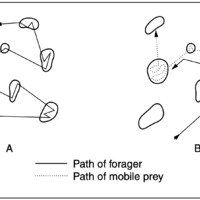Alternative Foraging Strategies in a Patchy Environment
Item
-
Title
-
Alternative Foraging Strategies in a Patchy Environment
-
Description
-
Winterhalder (1981a: 90) proposes that the Cree employ an ‘interstice’ rather than a ‘patch-to-patch’ strategy of foraging. It is a strategy that makes good sense when one is hunting animals, such as moose and caribou, which themselves move frequently from one patch to another, which are not particularly abundant in proportion to the number of patches they are associated with, and which leave tracks or trails that may be used by hunters as evidence for their recent movements and present whereabouts. Moving in the interstices between patches – mainly, that is, on the hard-packed snow of frozen lakes and creeks which in any case makes travel easier – the hunter can expect to intercept the tracks left by animals as they move from patch to patch, and will visit a patch only when the tracks indicate that favoured prey are present there. ‘Cree foragers’, Winterhalder remarks, ‘have developed this technique to a high level of skill’ (1981a: 91)
-
Designer
-
Winterhalder, Bruce
-
Date
-
1981
-
Source
-
Ingold, Tim. (2000). The perception of the environment: Essays on livelihood, dwelling and skill. Routledge.
-
Bibliographic Citation
-
Winterhalder and Smith (eds) Hunter-Gatherer Foraging Strategies, published by University of Chicago Press 1981.
-
has attribute
-
English
Arrow
-
English
Angled Line
-
English
Dash Line
 winterhalder
winterhalder